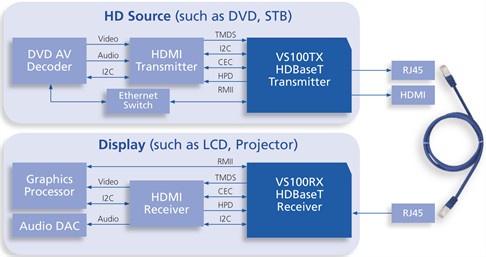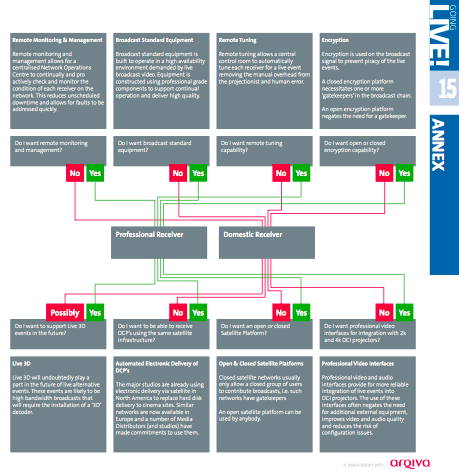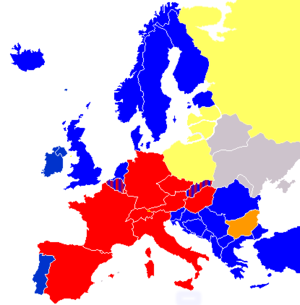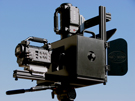Recently, there was a presentation of the system at the 3D Industry Summit in Universal City. As reported in Variety: “TrioScopics3D President and CEO John Lowry premiered his 3D system, which requires no investment in equipment from exhibitors…”
What is required at the exhibition end?
• A DCP* master created with the TrioScopic process (*DCP=Digital Cinema Package)
• Glasses from a TrioScopic licensee.
What isn’t required
• Color wheels or electro-optical modulators.
• Silver screen.
• Polarizing lenses.
• Left eye/right eye sequencing.
By definition, it is an anaglyph system, though just by looking at the glasses it is obviously different. (Anaglyph [from the Greek, to carve up – a method of encoding a three-dimensional image in a single picture by superimposing a pair of pictures.]
“I hate the word “anaglyph”, John says, “because it is associated with those horrible comic-book glasses, and bad effects. But there are other digital systems that are using anaglyph. During some research on another project, we decided that we could create and apply some interesting science to anaglyph.”
The system begins with a unique process during mastering. Instead of cyan/red lenses, it ends with a pair of glasses that have a lens pair of magenta and green, the hues of which, when combined, create white.
Hues of red and cyan can get close to white, but red has other problems in the human visual system. Red wavelengths create different focusing challenges for the eye/brain pair for example. Older systems have tried to fix the many problems by adding magnification into the red eye, and leaking red into both pictures to handle obvious reds like lipstick.
“Our hues of magenta/green are far more comfortable for long-term viewing. We have had 3 major movie studio releases to the home, plus other presentations. We have enough experience now to know that our system doesn’t cause headaches or other problems.
“It isn’t only the glasses; the precision of our processing creates a great image with a full range of colors and perfectly balanced luminance. This has evolved with each movie we have been involved in. We are quite proud of what we can do now.”
What about contracts or per movie royalties?
“We’re not going in that direction. We do make a royalty on the glasses, but it doesn’t greatly influence the price of those. We will know the quantity pricing for theatrical glasses very soon, but we know that they will be comparably inexpensive, and either recyclable or disposable.
“Up until now, the system has been used for Blu Ray releases on 3 major movies: Journey to the Center of the Earth, My Bloody Valentine, and Coraline. There is also a great clip that uses everything that we have learned to date called B.O.B.’S Big Break on the Monsters v Aliens disk.
“There are over 60 million sets of glasses in homes now, being used on all types of current televisions. Again, just like what we can propose to the studios and exhibitors, this doesn’t require anything more than the end user already has.
“This is a proven technology now, one that will continue to make a market that can help drive 3D all the way through the chain. It will help make theatrical release viable, it will help make 2D to 3D conversion of the studios libraries by groups such as InThree viable. The process even works well all the way down to movies on the iPhone.”
In the background of 3D and all things digital, there are several concepts that make the market unsettled. There is yet to be any system that has been through the DCI Compliance steps. The 3D standards are still a work in process. There are several 3D systems available, all of which are satisfying customers, but all of which are also in the process of being bettered. A new 3D system was recently proposed by Technicolor that works with film projectors, which, by the nature of its over/under technique, stabilizes several of the difficulties of prior film-based systems. So, one wonders, is this a stop-gap system, an interim system?
“Well, it depends on what you mean by interim. We think of interim as 5-10 years. We couldn’t tell you what might happen with technology out that far.
“But our system will work for exhibitors for as long as the current specs and DCP are around.”
Other answers:
- Watermarking – Don’t anticipate a problems, but that is in test.
- Macrovision? (now Rovi) – Have delivered 3 movies without problems.
- Application with live events? We are moving on this now, with several interesting prospects to talk about soon. Our process is very fast, so we can offer an economical method of putting live 3D pictures on a stadium screen, into a theater and onto a high-def screen in the bar or home.
Questions not asked.
- We were unable to get specifics on the technology (what is done).
- What is the White Point chosen. What is the color space, and color depth.
- What level of light hits the eyes.
- Application with games? During a Lenny Lipton interview recently, he mentioned that his kids would be found playing 3D games with the glasses off. The speed hit and the faux color seemed to be worse than the distortion of watching the game in 3D.
- Any association with DTS/Reliance?
- Patented Process? or remain a proprietary process?
- Prospect for simultaneous 2D and 3D system?
- Extra bandwidth for 3D HD broadcast format?
- European prospects/Opinions on subtitling
TrioScopics3D Site – A 3-D Distribution Solution for 3-D Entertainment
Apollo 11 moonwalk video restored by Lowry Digital
Same topic writen up well at Home Cinema Choice
John Lowry Bio
Co-Founder, TrioScopics 3D
John Lowry is an imaging visionary who has worked 57 years in the motion picture and television industry. Behind Lowry’s long history of image science breakthroughs is his resolutely unconventional approach to solving problems.
In the early 1970s, Lowry was a pioneer in designing digital video systems and tools. For the past 35 years, his primary focus has been the design and development of digital image processing systems to improve the quality of motion picture images. The Lowry Process™, a unique proprietary image processing technology that he developed, has been used to fine tune motion pictures like The Curious Case of Benjamin Button, as well as to restore hundreds of cinema classics including Citizen Kane, Rashomon and the James Bond and Disney Classics libraries.
Most recently, The Lowry Process was used to restore video images from the Apollo 11 moonwalk for NASA.
Today, Lowry is active with Lowry Digital, which he founded 11 years ago, and TrioScopics, the 3-D company he founded almost three years ago with Ian Caven.
TrioScopics has developed a 3-D system for distribution applications that, unlike other current 3-D techniques, does not require specialized players, projectors or display equipment, and utilizes inexpensive glasses with proprietary green-magenta filters.
Lowry holds numerous patents on motion image processing technology and is a Life Fellow of the Society of Motion Picture and Television Engineers.




 Element Technica Quasar™ 3D Rigs Now in Use
Element Technica Quasar™ 3D Rigs Now in Use 3D Film Factory Introduces First Affordable 3D Rig For Red One Cameras
3D Film Factory Introduces First Affordable 3D Rig For Red One Cameras